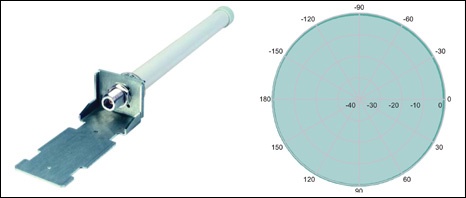Industrial Wireless – Selecting the Right Antenna for Your Application
As a network designer or engineer, you might avoid wireless solutions because you are worried that transmission interference will make network communications unreliable. Although you may have heard of recent technical improvements in industrial wireless technology, you may still be concerned about using it for mission-critical processes.
In addition, you might wonder if WLAN transmission equipment can provide the mechanical stability, temperature range, moisture levels and corrosion resistance needed to operate effectively in your facility.
While other articles in this blog have described some of the advances in technology and standards that have made industrial wireless applications very reliable, this article takes a close look at one key component. That component is the antenna.
Selecting the right antenna technology is essential for dependable WLAN connections. Let’s examine how to go about it.

Industrial wireless applications can replace trailing cable connections to mobile loading equipment. The result is reduced repair costs plus improved communication reliability.
1. Select the Right Antenna Technology for the Job
There are two primary types of antennas used in wireless networks – directional and omni-directional (commonly referred to as just omni). Directional antennas point radio frequency (RF) in a specific direction for RF concentration within a targeted area. Omni antennas provide equal coverage in all directions, with a coverage pattern that looks like a sphere.
To connect buildings over point-to-point links in outdoor areas, directional antennas would be the most suitable. Directional antennas have different opening angles, in which they bind (bundle) the send/receive signal. For short distances, wide angles are common. For longer distances, e.g. 1000m or more, a more acute angle is preferable (30° or less). Directional antennas further confine and restrict these areas by bundling the send/receive signal in a unidirectional way, thus generating a much greater range (see Figure 1).

Figure 1 – Directional antennas are good for point-to-point connections. For shore distances, a wide angle of transmission is appropriate.
For rooms and open areas in the interior and exterior, most often the omni antenna is the better technology because of its ability to cover a circular area. The particular range depends on the sensitivity of the antenna (see Figure 2).

Figure 2 – Omni-directional antennas are good for indoor or outdoor open areas.
The newer wave of WLAN technology also supports MiMo (Multiple In Multiple Out) antennas. MiMo antennas consist of a single structure containing up to three single antenna elements inside.
These antennas actively utilize reflections and delays in signal propagation to combine more than one stream. This enables a higher data rate and a better quality of connectivity in “noisy” environments. This construction is available for both omni and directional antennas (download the white paper below for more information on MiMo antenna usage).
2. Select the Right Antenna Frequency
To further guide you towards the right antenna, consider the frequency range that will best suit your application. The table below provides typical antenna ranges for the two possible frequency ranges supported by the IEEE 802.11 WLAN specification.

A way to narrow down antenna choices is to use the Hirschmann Antenna Guide in combination with the Hirschmann WLAN distance calculator. These tools help you select a category of antenna and then enter your specific calculations to determine the most suitable product.
3. Define Application Specific Requirements
To narrow down your requirements, consider questions such as the following:
- Is the communication fixed between different areas, like a point-to-point link?
- Does the signal need to cover a wide area, such as a factory floor?
- Are there clients (devices like phones, laptops, tablets) that are moving and need to have uninterrupted coverage of the whole area?
- As clients move around, are small breaks in communications acceptable?
- What sort of data traffic types will be used in these applications — simple low data rate PLC communication or high bandwidth HD video? Maybe even a little of both?
With this information in hand, you are ready to select the right antenna.
Example Application: Mobile Equipment in a Large Production Area
In this real-life application, mobile loading devices were initially connected by a trailing cable. This trailing cable needed to be repaired on a regular basis. A maintenance-free solution was desired, along with the ability to provide a connection for the transmission of control and measurement data. It was therefore decided to evaluate a WLAN solution as an option.
With the requirement to reach WLAN clients in a medium distance range (109 yards to 1,093 yards or 100m to 1km), directional antennas pointing at the moving sand loading devices or clients offered a good starting point.
To get the desired radio coverage for the active area, two directional antennas were required to meet the coverage angles. These antennas were mounted on a fixed central site. In addition, with the throughput demands of the site, directional antennas were also used.
The selected directional antennas were 9dBi (decibel isotropic) and had an opening angle of 60°. These antennas support, over the whole moving area, a Signal-to-Noise ratio (SNR) of more than 20dB. With these real measurements, the required minimum throughput of 12Mbit/s was not only met but greatly exceeded. The selected antennas ensured equal visibility between the loading units and the central station along the entire route.
Industrial Wireless Benefits: Cost Savings, Reliability and Competitive Advantage
As the above example illustrates, moving a high repair application such as a trailing cable to a maintenance-free radio connection reduces costs. Other ways that industrial wireless can save money might come from reduced personnel, support or set-up costs.
Furthermore, today’s wireless technologies achieve the reliability of cable connections in 90% of applications.
Industrial wireless applications contribute to competitive advantage by improving processes such as real-time status of mobile devices, shorter startup times and reductions in minor breakdowns.
![System.String[]](https://assets.belden.com/transform/7d9664bf-965d-4965-a32d-382a9829c061/Author-Belden-Logo-sm-blue-2020-10?io=transform:fill,width:300,height:300)